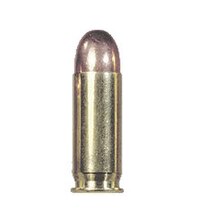The .38 Super cartridge has a rich history that spans over a century, evolving from a competition-focused round to a viable option for self-defense.
Originally developed in the early 20th century, the .38 Super has undergone various changes and adaptations, making it a popular choice among shooters for different applications.
This article explores the origins of the .3 8 Super, its development for competitive shooting, and its eventual adoption for self-defense purposes.
Origins of the .38 Super
The .38 Super was introduced in 1929 by Colt as a response to the growing demand for a more powerful cartridge than the standard .38 ACP (Automatic Colt Pistol). The .3 8 Super was designed to be used in the Colt M1911 pistol, which was already a popular choice among military and law enforcement personnel. The cartridge was developed to provide higher velocity and energy, making it suitable for various shooting applications.
The .3 8 Super features a slightly longer case than the .38 ACP, allowing for a larger powder charge. This design change resulted in a cartridge capable of achieving higher velocities, typically around 1,200 to 1,300 feet per second, depending on the load. The increased performance made the .3 8 Super an attractive option for competitive shooters, particularly in the early days of practical shooting competitions.
The Rise of Competitive Shooting
In the decades following its introduction, the .38 Super gained popularity in the competitive shooting community. The cartridge’s high velocity and flat trajectory made it ideal for various shooting disciplines, including IPSC (International Practical Shooting Confederation) and USPSA (United States Practical Shooting Association). Shooters appreciated the .3 8 Super for its accuracy and manageable recoil, allowing for quick follow-up shots.
The .3 8 Super became a favorite among competitive shooters, particularly in the 1980s and 1990s, when practical shooting competitions gained traction. Many custom gunsmiths began to modify 1911-style pistols to accommodate the .3 8 Super, enhancing its performance and reliability. The cartridge’s popularity in competition led to increased availability of factory-loaded ammunition and reloading components, further solidifying its place in the shooting sports community.
Transition to Self-Defense
While the .38 Super was primarily associated with competition, its characteristics also made it a viable option for self-defense. As the demand for effective self-defense cartridges grew, many shooters began to recognize the advantages of the .38 Super for personal protection. The cartridge’s high velocity and energy levels provided excellent stopping power, making it suitable for defensive use.
In the late 20th century, the .3 8 Super began to gain traction among law enforcement agencies and civilian concealed carry enthusiasts. The cartridge’s ability to penetrate barriers, such as clothing and car doors, made it an attractive option for self-defense situations. Additionally, the .38 Super’s compatibility with the 1911 platform, a widely respected and trusted firearm, further contributed to its adoption for personal protection.
Advantages of the .3 8 Super for Self-Defense
-
High Velocity and Energy: The .38 Super’s design allows it to achieve higher velocities than many other self-defense cartridges, resulting in increased energy transfer upon impact. This characteristic can lead to more effective stopping power in defensive situations.
-
Flat Trajectory: The cartridge’s flat trajectory makes it easier to shoot accurately at various distances. This is particularly beneficial in self-defense scenarios, where quick and precise shots may be necessary.
-
Reduced Recoil: Compared to larger calibers, the .3 8 Super offers manageable recoil, allowing for faster follow-up shots. This can be crucial in high-stress situations where every second counts.
-
Versatility: The .38 Super can be loaded with a variety of bullet types and weights, allowing shooters to tailor their ammunition to specific needs. From hollow points for self-defense to full metal jackets for practice, the versatility of the cartridge makes it appealing to a wide range of users.
-
Compatibility with 1911 Platforms: The .3 8 Super is primarily chambered in the 1911 pistol, a firearm known for its reliability and accuracy. Many shooters prefer the 1911 platform for self-defense, making the .38 Super a natural choice for those who appreciate this iconic handgun.
Challenges and Considerations
The .38 Super was developed in 1929 by Colt as an improvement over the .38 ACP (Automatic Colt Pistol). The goal was to create a cartridge that offered higher velocity and energy, making it suitable for various applications, including law enforcement and military use. The .38 Super features a longer case than the .38 ACP, allowing for a larger powder charge and resulting in higher velocities—typically around 1,200 to 1,300 feet per second.
The cartridge was designed to be used in the Colt M1911 pistol, which was already a popular choice among military and law enforcement personnel. The .3 8 Super quickly gained a reputation for its accuracy and performance, making it a favorite among competitive shooters.
In the decades following its introduction, the .38 Super became a staple in the competitive shooting community. Its high velocity and flat trajectory made it ideal for various shooting disciplines, including IPSC (International Practical Shooting Confederation) and USPSA (United States Practical Shooting Association). Shooters appreciated the .3 8 Super for its accuracy and manageable recoil, allowing for quick follow-up shots.
The 1980s and 1990s saw a surge in practical shooting competitions, and the .3 8 Super became a favored choice among competitors. Many custom gunsmiths began to modify 1911-style pistols to accommodate the .38 Super, enhancing its performance and reliability. The cartridge’s popularity in competition led to increased availability of factory-loaded ammunition and reloading components, further solidifying its place in the shooting sports community.
Despite its advantages, the .3 8 Super is not without challenges. One of the primary concerns is the availability of ammunition. While it has become more accessible in recent years, it is still less common than other self-defense cartridges, such as the 9mm or .45 ACP. This can make it more challenging for shooters to find ammunition, particularly in times of high demand.
Additionally, the .38 Super may not be as widely recognized as a self-defense cartridge compared to more established options. Some individuals may be hesitant to choose it for personal protection due to a lack of familiarity or understanding of its capabilities.
As the .3 8 Super gained popularity for self-defense, it also found its way into law enforcement agencies. Some police departments began to adopt the cartridge for use in their sidearms, particularly in jurisdictions where the 1911 was already in service. The .38 Super’s ability to deliver effective stopping power and its compatibility with the 1911 platform made it an appealing choice for officers.
However, as law enforcement agencies began to transition to more modern calibers, such as the 9mm and .40 S&W, the use of the .3 8 Super in police work declined. Despite this, the cartridge remains a viable option for off-duty carry and personal protection among some law enforcement personnel.
Modern Developments and Trends
In recent years, the .38 Super has experienced a resurgence in popularity, particularly among enthusiasts
Conclusion
The evolution of the .38 Super from a competition-focused cartridge to a viable option





